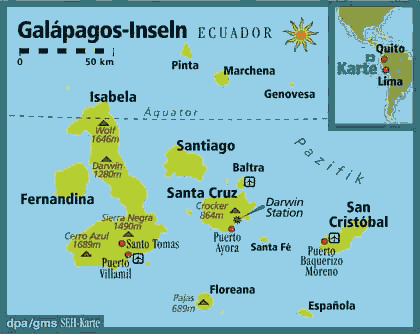
The Galapagos archipelago is best known for its amazing array of endemic species. These plants, invertebrates and vertebrate species have evolved over time due to isolated island life. Endemism is high in all living organisms on these islands from lichens, flowering plants, insects and land snails to finches, giant tortoises, iguanas and rats.
Darwin first studied the wildlife of the islands taking note of the evolution of the landbirds such as finches and mockingbirds that adapted to a specific niche in the available habitat. These islands are a natural, living laboratory with minimal human disturbance until recently. Only five of the islands are inhabited. These islands are some of the largest and thus contain some of the highest diversity. The variation in elevation, size, and distance between the islands has contributed greatly towards the species diversity and level of endemism on each island.

The Galapagos Islands are part of Ecuador although they lie in the Pacific Ocean about 960 km to the west of mainland South America. This unique ecoregion encompasses the entire Galapagos archipelago including 13 islands larger than 10 km2, 19 larger than 1 km2, 42 islets smaller than 1 km2 and at least 26 emergent rocks. There are approximately 128 named islands in the archipelago with Isabela as the largest with 4,588 km2 reaching an elevation of 1,707 m and Darwin as the smallest with only 1.1 km2 and an elevation of 168 m. The total land area of the ecoregion sums to 7,882 km2, with 1336 km of coastline.

Four of the islands are inhabited: Isabela, Santa Cruz, San Cristóbal and Floreana (Acharya 2000). A defence base is also located on Baltra Island resulting in a combined resident human population of about 17,000 (Acharya 2000). Fresh water is a limiting factor for humans. Only one island, San Cristobal has a perennial water supply that can adequately sustain humans. Seasonal springs occur on Santa Cruz and Floreana. Brackish water is available on all the inhabited islands (WCMW 1990).
Darwin first studied the wildlife of the islands taking note of the evolution of the landbirds such as finches and mockingbirds that adapted to a specific niche in the available habitat. These islands are a natural, living laboratory with minimal human disturbance until recently. Only five of the islands are inhabited. These islands are some of the largest and thus contain some of the highest diversity. The variation in elevation, size, and distance between the islands has contributed greatly towards the species diversity and level of endemism on each island.

The Galapagos Islands are part of Ecuador although they lie in the Pacific Ocean about 960 km to the west of mainland South America. This unique ecoregion encompasses the entire Galapagos archipelago including 13 islands larger than 10 km2, 19 larger than 1 km2, 42 islets smaller than 1 km2 and at least 26 emergent rocks. There are approximately 128 named islands in the archipelago with Isabela as the largest with 4,588 km2 reaching an elevation of 1,707 m and Darwin as the smallest with only 1.1 km2 and an elevation of 168 m. The total land area of the ecoregion sums to 7,882 km2, with 1336 km of coastline.

Four of the islands are inhabited: Isabela, Santa Cruz, San Cristóbal and Floreana (Acharya 2000). A defence base is also located on Baltra Island resulting in a combined resident human population of about 17,000 (Acharya 2000). Fresh water is a limiting factor for humans. Only one island, San Cristobal has a perennial water supply that can adequately sustain humans. Seasonal springs occur on Santa Cruz and Floreana. Brackish water is available on all the inhabited islands (WCMW 1990).

No comments:
Post a Comment